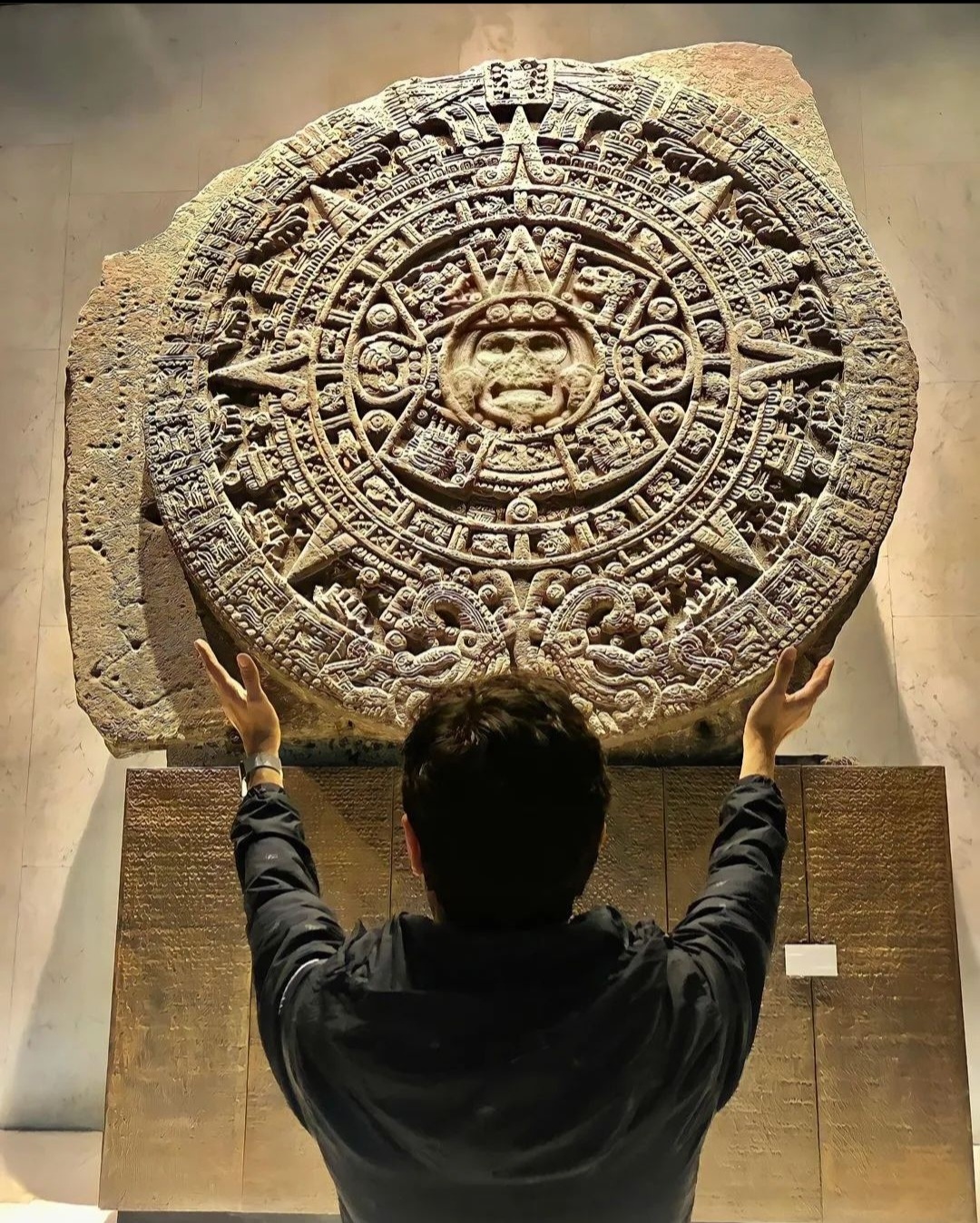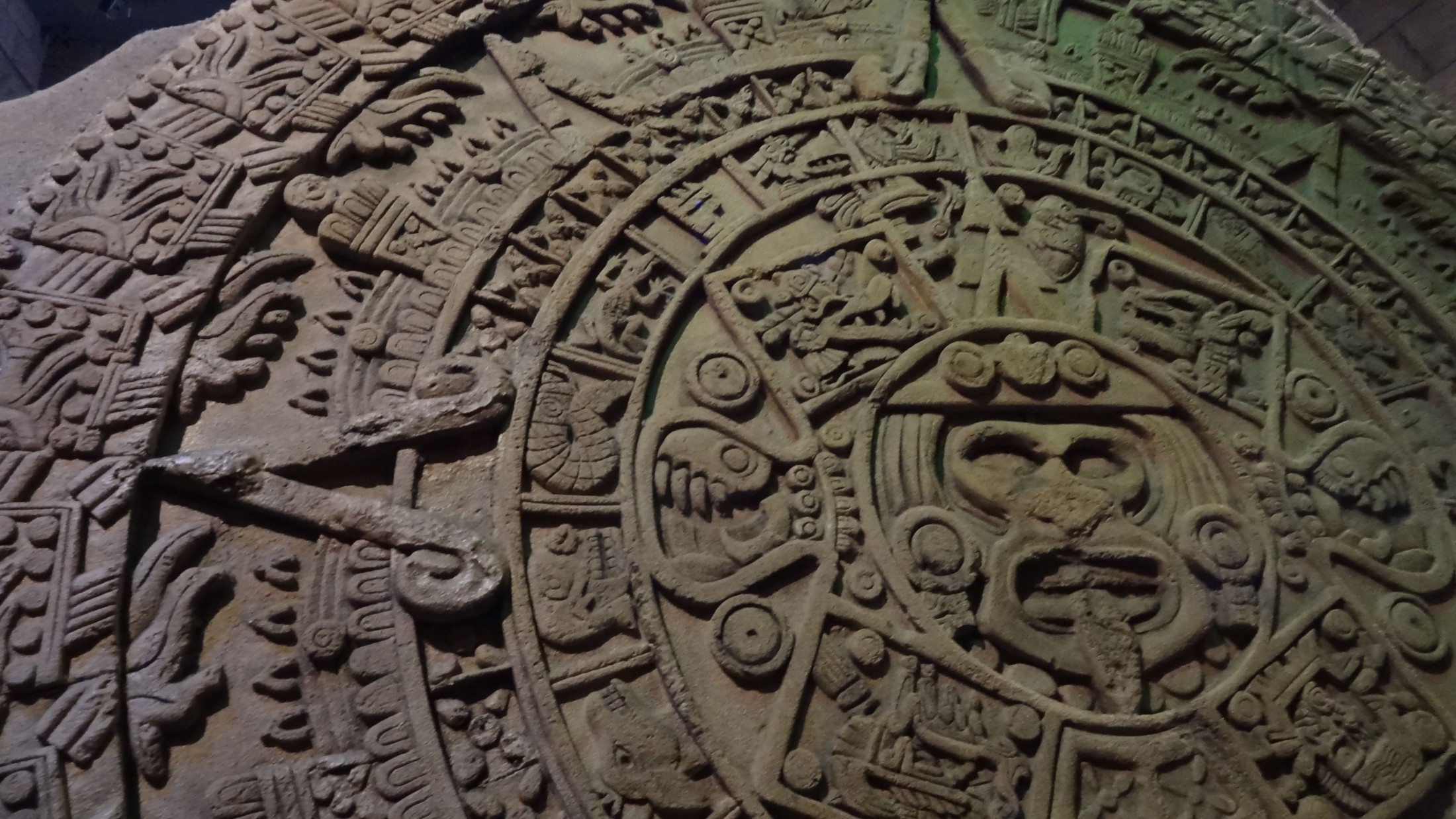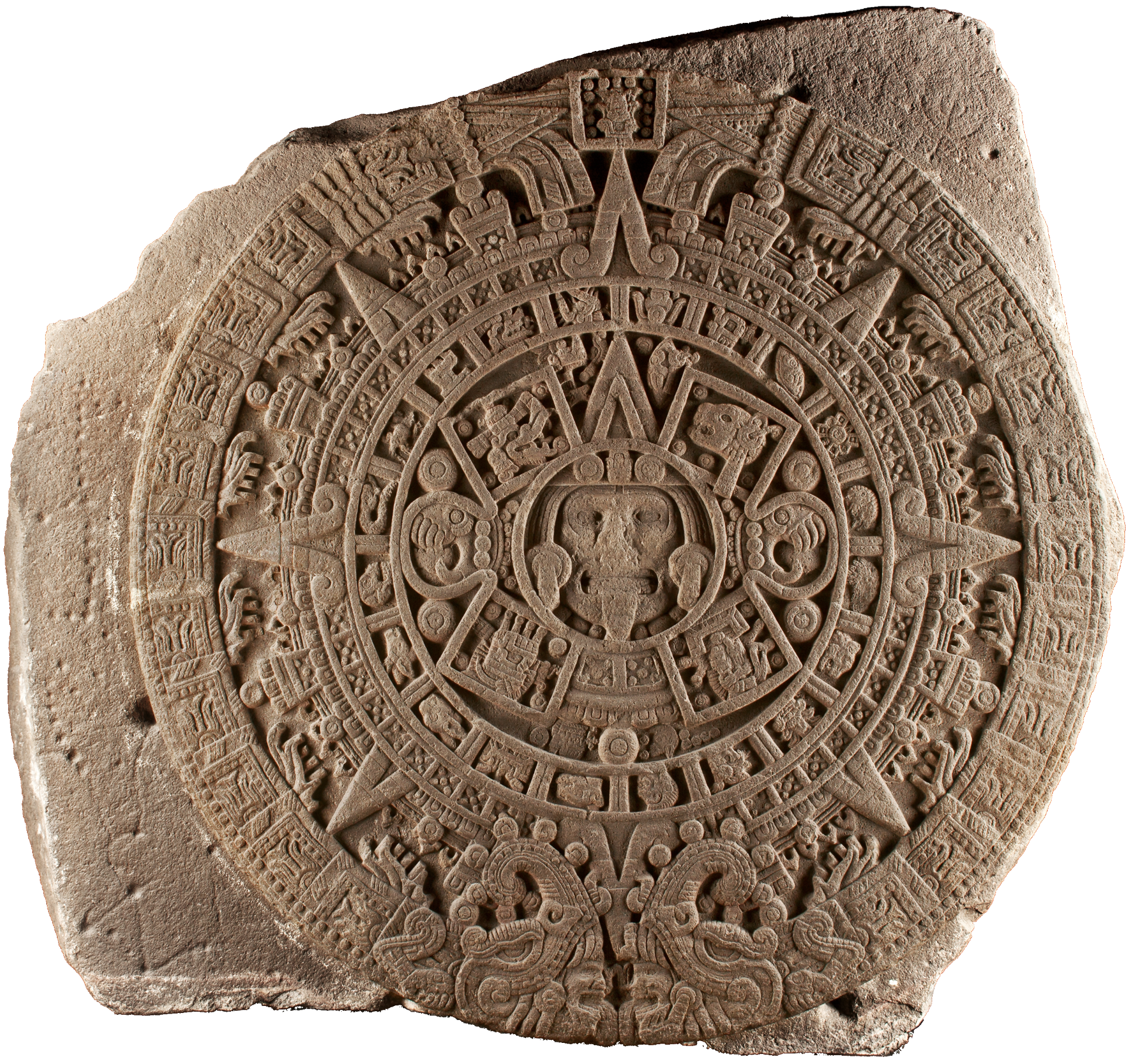Introduction
In the bustling heart of Mexico City, a remarkable discovery was made in 1790 CE that would forever change our understanding of the Aztec civilization. Buried beneath the city streets, archaeologists uncovered a colossal basalt carving, which would become renowned as the Aztec Sun Stone. This intricately crafted masterpiece, weighing over 24 tons, would soon captivate global audiences with its complex symbolism and profound cosmological significance.

The Aztec Sun Stone, also known as the Calendar Stone, is a stunning example of the advanced astronomical and religious knowledge possessed by the Aztec people. This magnificent artifact, which measures over 12 feet in diameter, is a testament to the ingenuity and sophistication of the Aztec culture. Through the intricate carvings and intricate designs etched into its surface, the Sun Stone reveals a wealth of information about the Aztec’s cosmological beliefs, their understanding of the celestial movements, and their reverence for the sun as a central figure in their religious and cultural traditions.
In this blog post, we will delve deep into the mysteries of the Aztec Sun Stone, unraveling the layers of symbolism and exploring the insights it provides into the ancient Aztec worldview. We will examine the stone’s intricate design, the significance of its various elements, and how it reflects the Aztec’s sophisticated understanding of the cosmos. By deciphering the secrets of this remarkable artifact, we can gain a deeper appreciation for the rich cultural heritage of the Aztec civilization and the enduring legacy they have left behind.
The Aztec Sun Stone: A Masterpiece of Craftsmanship
The Aztec Sun Stone is a truly remarkable feat of craftsmanship, showcasing the exceptional skills and attention to detail of the Aztec artisans who created it. The stone is carved from a single massive block of basalt, a type of volcanic rock known for its durability and resistance to weathering. The intricate carvings and intricate designs that adorn the surface of the stone are a testament to the Aztec’s mastery of stonework and their deep understanding of the natural world.
At the center of the Sun Stone is a captivating image of the sun god, Tonatiuh, the deity responsible for the movement of the sun and the cycle of day and night. Tonatiuh is depicted with an open maw, ready to devour the sacrificial hearts of his devotees, a reflection of the Aztec’s belief in the importance of human sacrifice to sustain the sun’s journey across the sky.

Surrounding the central image of Tonatiuh are a series of concentric circles, each representing a different aspect of the Aztec cosmological system. The outermost ring is divided into 20 sections, each representing one of the 20 day signs that made up the Aztec calendar. These day signs, such as the Jaguar, the Reed, and the Flint Knife, were believed to have a profound influence on the events and outcomes of each day.
Moving inward, the next ring is divided into 4 quadrants, each representing one of the four cardinal directions – north, south, east, and west. These directional symbols were of great importance to the Aztec, as they believed that the cosmos was divided into four distinct realms, each with its own unique characteristics and spiritual significance.
The innermost ring of the Sun Stone is perhaps the most complex and intriguing, depicting a series of 52 glyphs that represent the 52-year cycle of the Aztec calendar. This intricate system of timekeeping was a testament to the Aztec’s advanced understanding of astronomy and their ability to precisely track the movements of the heavenly bodies.
The sheer level of detail and symbolism present in the Aztec Sun Stone is truly awe-inspiring. Every element of the stone, from the central image of Tonatiuh to the intricate calendrical markings, was imbued with deep spiritual and cosmological significance, reflecting the Aztec’s profound reverence for the natural world and their belief in the interconnectedness of all things.
Unlocking the Secrets of the Aztec Calendar
At the heart of the Aztec Sun Stone’s significance is its intricate representation of the Aztec calendar system, which was a remarkable feat of astronomical and mathematical prowess. The Aztec calendar was a complex system that combined two separate calendars – the solar calendar and the ritual calendar – to create a comprehensive system of timekeeping that was essential to the Aztec’s religious and cultural traditions.
The solar calendar, known as the Xiuhpohualli, was a 365-day calendar that tracked the movement of the sun and the changing of the seasons. This calendar was divided into 18 months, each consisting of 20 days, with an additional 5 “unlucky” days at the end of the year. The Aztec believed that these 5 days were a time of great spiritual uncertainty and vulnerability, as the sun’s journey through the heavens was temporarily interrupted.

Alongside the solar calendar was the ritual calendar, known as the Tonalpohualli, which was a 260-day cycle that was used to track the sacred cycles of the cosmos and to determine the auspicious timing for important events, such as religious ceremonies, agricultural activities, and military campaigns. This calendar was divided into 20 day signs, each with its own unique set of characteristics and spiritual associations.
The Aztec Sun Stone beautifully represents the intricate interplay between these two calendars, with the 20 day signs of the Tonalpohualli displayed in the outermost ring and the 52-year cycle of the combined calendars depicted in the innermost ring. This 52-year cycle, known as the “Calendar Round,” was a crucial component of the Aztec’s cosmological beliefs, as it was believed to represent the cyclical nature of time and the eternal renewal of the cosmos.
By deciphering the complex symbolism and intricate calendrical markings on the Aztec Sun Stone, we can gain a deeper understanding of the Aztec’s sophisticated understanding of the heavens and their belief in the interconnectedness of all things. The stone’s representation of the Aztec calendar system, with its precise tracking of the sun’s movements and the sacred cycles of the cosmos, is a testament to the Aztec’s advanced scientific and mathematical knowledge, as well as their deep reverence for the natural world.
The Aztec Cosmological Worldview
The Aztec Sun Stone is not merely a representation of the Aztec calendar system, but a window into the Aztec’s complex and multifaceted cosmological beliefs. The intricate carvings and symbolic elements of the stone reflect the Aztec’s profound understanding of the universe and their place within it.
At the center of the Aztec cosmological worldview was the belief in the cyclical nature of time and the eternal renewal of the cosmos. The Aztec saw the universe as a series of interconnected cycles, with the sun’s journey across the sky being the most crucial of these cycles. The Aztec believed that the sun’s movement was sustained by the constant sacrifice of human hearts, which was seen as a necessary and sacred act to ensure the continuation of the cosmic order.

This belief in the importance of human sacrifice is reflected in the central image of the Aztec Sun Stone, which depicts the sun god, Tonatiuh, with an open maw, ready to devour the sacrificial hearts of his devotees. The Aztec saw this act of sacrifice as a way to maintain the balance and harmony of the cosmos, ensuring that the sun would continue its eternal journey across the sky.
Surrounding the central image of Tonatiuh are the various symbolic elements that represent the Aztec’s understanding of the structure of the universe. The four quadrants of the second ring, for example, represent the four cardinal directions, which were believed to be the four realms of the cosmos – the upper world, the lower world, the east, and the west. Each of these realms was believed to have its own unique spiritual and cosmological significance, and the Aztec saw it as their duty to maintain the balance and harmony between these realms.
The innermost ring of the Aztec Sun Stone, with its 52 glyphs representing the 52-year cycle of the Aztec calendar, further reflects the Aztec’s belief in the cyclical nature of time. The Aztec saw this 52-year cycle as a period of renewal and rebirth, a time when the cosmos would be reborn and the cycle of life would begin anew.
By deciphering the complex symbolism and cosmological beliefs represented in the Aztec Sun Stone, we can gain a deeper understanding of the Aztec’s worldview and their profound reverence for the natural world. The stone’s intricate carvings and intricate designs serve as a testament to the Aztec’s advanced scientific and mathematical knowledge, as well as their deep spiritual and cultural traditions.
The Enduring Legacy of the Aztec Sun Stone
The Aztec Sun Stone is a remarkable and enduring legacy of the Aztec civilization, a testament to their advanced scientific and cultural achievements. Even centuries after its discovery, this colossal basalt carving continues to captivate and intrigue scholars, historians, and the general public alike.
One of the most remarkable aspects of the Aztec Sun Stone is its enduring relevance and significance in the modern world. Despite the passage of time and the dramatic cultural and societal changes that have occurred since the Aztec civilization’s decline, the Sun Stone remains a potent symbol of the Aztec’s rich cultural heritage and their profound understanding of the natural world.

Today, the Aztec Sun Stone is housed in the National Anthropology Museum in Mexico City, where it continues to draw visitors from around the world who come to marvel at its intricate design and to learn more about the Aztec’s sophisticated cosmological beliefs. The stone has become a touchstone for the Aztec’s cultural legacy, inspiring artists, scholars, and the general public to delve deeper into the mysteries of this remarkable artifact.
Beyond its role as a cultural and historical artifact, the Aztec Sun Stone has also become an important tool for scholars and researchers who are working to unravel the complexities of the Aztec civilization. By studying the stone’s intricate carvings and symbolic elements, researchers have been able to gain valuable insights into the Aztec’s advanced understanding of astronomy, mathematics, and the natural world.
Moreover, the Aztec Sun Stone has become a source of inspiration and pride for the Aztec’s descendants, who continue to celebrate and honor the cultural legacy of their ancestors. The stone’s enduring significance serves as a powerful reminder of the Aztec’s enduring influence on the cultural landscape of Mexico and the broader world.
In conclusion, the Aztec Sun Stone is a truly remarkable and captivating artifact that continues to inspire and captivate audiences around the world. By deciphering the mysteries of this colossal basalt carving, we can gain a deeper understanding of the Aztec’s sophisticated cosmological beliefs, their advanced scientific and mathematical knowledge, and their profound reverence for the natural world. The Aztec Sun Stone stands as a testament to the enduring legacy of the Aztec civilization and the profound impact it has had on the cultural and intellectual landscape of the world.
Conclusion
The Aztec Sun Stone is a remarkable and enduring legacy of the Aztec civilization, a testament to their advanced scientific and cultural achievements. Through the intricate carvings and symbolic elements of this colossal basalt carving, we can gain a deeper understanding of the Aztec’s sophisticated cosmological beliefs, their advanced understanding of astronomy and mathematics, and their profound reverence for the natural world.
By deciphering the mysteries of the Aztec Sun Stone, we can uncover the rich cultural heritage of the Aztec people and appreciate the enduring significance of this remarkable artifact in the modern world. The stone’s captivating design, its intricate calendrical markings, and its symbolic representations of the Aztec’s cosmological beliefs continue to captivate and inspire audiences around the world.
As we delve deeper into the secrets of the Aztec Sun Stone, we are reminded of the remarkable achievements of this ancient civilization and the enduring legacy they have left behind. The stone’s enduring relevance and significance serve as a testament to the Aztec’s profound impact on the cultural and intellectual landscape of the world, and a reminder of the importance of preserving and honoring the rich cultural heritage of all civilizations.

